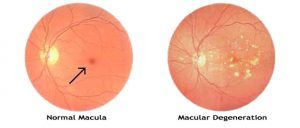The  macula is a small area in the eye responsible for our precious central vision, color perception and therefore, our independence. It is a delicate tissue comprising only a few millimeters of the retinal lining that surrounds the inside of our eye. Age-related Macular degeneration(AMD) is a medical condition affecting 8 million Americans, accounting for more than 50% of all vision loss in the US caucasian population. This condition is constantly growing with our aging population and expanding life expectancies. Important risk factors include family history, smoking, age, Ultra Violet exposure, diet, hypertension, and high cholesterol. While genetics explain upwards of 60% of the risk, a complex interaction of unfavorable environmental and lifestyle events account the the remaining risk of progression. Most common signs and symptoms are distorted or missing area of vision, shadows, slow recovery time, declining color perception, and contrast sensitivity.
macula is a small area in the eye responsible for our precious central vision, color perception and therefore, our independence. It is a delicate tissue comprising only a few millimeters of the retinal lining that surrounds the inside of our eye. Age-related Macular degeneration(AMD) is a medical condition affecting 8 million Americans, accounting for more than 50% of all vision loss in the US caucasian population. This condition is constantly growing with our aging population and expanding life expectancies. Important risk factors include family history, smoking, age, Ultra Violet exposure, diet, hypertension, and high cholesterol. While genetics explain upwards of 60% of the risk, a complex interaction of unfavorable environmental and lifestyle events account the the remaining risk of progression. Most common signs and symptoms are distorted or missing area of vision, shadows, slow recovery time, declining color perception, and contrast sensitivity.
Treatment and management depend on the form and stage of the disease, but prevention and early detection are paramount. Concisely, the dry form causes slow atrophy and scarring due to cellular debri accumulation, called drusen, and is divided into three progressive stages. Duly noted, is a link to Alzheimers disease, due to the similarity of the drusen accumulation. Retinal imaging is being explored as a future indicator of this disease. Genetic testing of specific markers are strong predictors of risk/progression of these age related diseases, but can be an expensive option. The goal is to promote prevention and reduce progression through lifestyle changes and supplementation of carotenoids, such as lutein and zeaxanthin with omega-3s. Studies have shown that a combination of these supplements reduce the risk of progression(see AREDS 2 study). Cessation of smoking is imperative. UltraViolet Radiation protection when outdoors and protection from extended exposure to high-energy visible light emitted from digital devices, known as Blue Light, is also crucial. The wet form of macular degeneration is less common(10-20%), but has a rapid onset. It usually preceded by the dry form, but not always. It is caused by abnormal blood vessel growth that leak and require treatment immediately upon diagnosis, with early detection leading to more favorable outcomes. The mainstay of treatment for wet AMD is monthly ocular injections to reduce leakage and prevent further blood vessel growth. Although this procedure may seem extraordinarily undesirable, it is relatively painless and preserves sight for this aging demographic that would otherwise have lost their independence. Previous treatments include lasers that scar the macula resulting in permanent vision loss, but halted new blood vessel growth.
Several new treatment options are being explored for this disease. The optimistic results of a topical maintenance drop daily instead of monthly injections are on the horizon. Promising stem cell research results will dramatically change the future treatment. Reducing risk factors is the paramount in those genetically predisposed. At Envision Eyecare, we evaluate an indicator of risk on every patient over 40(or family risk of AMD and Diabetics), known as the Macular Pigment Optical Density(MPOD). With dietary changes and/or supplementation, we have documented significant improvements in pigment density, which study indicate shield the macula from deleterious effects of high-energy blue light. Being proactive can function as a barrier to those at risk. Our team at Envision Eyecare is passionate about enhancing, protecting, and preserving our patients vision. We provide education on technology that completely filters the blue light to protect the macula, also promoting less fatigue on digital devices and enhancing deep sleep patterns. In later stages of AMD, low vision therapy specifically designed for patient needs, including devices such as magnifiers, specular telescopes, computer applications and closed-circuit TVs, can also be helpful in maintaining independence.
In the next edition, I will explore the holistic approach to ocular health and vision correction with an open mind, addressing the insightful benefits and gross misconceptions that concern me from an evidence based prospective. Balance is essential. Knowledge is awareness. Stay connected. Protect your eyes and enjoy your sight!
All the best,
Dr. B


